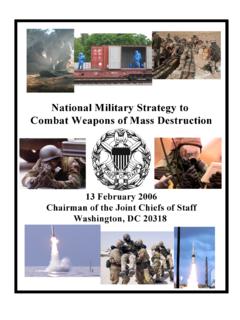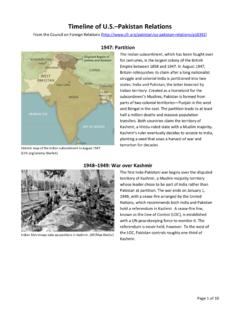Transcription of NATIONAL DEFENSE RESEARCH INSTITUTE and PROJECT AIR …
1 This document and trademark(s) contained herein are protected by law as indicated in a notice appearing later in this work. This electronic representation of RAND intellectual property is provided for non-commercial use only. Unauthorized posting of RAND PDFs to a non-RAND Web site is prohibited. RAND PDFs are protected under copyright law. Permission is required from RAND to reproduce, or reuse in another form, any of our RESEARCH documents for commercial use. For information on reprint and linking permissions, please see RAND Electronic Distribution RightsVisit RAND at RAND NATIONAL DEFENSE RESEARCH INSTITUTE RAND PROJECT AIR FORCEView document detailsFor More InformationThis PDF document was made available from as a public service of the RAND down to documentTHE ARTSCHILD POLICYCIVIL JUSTICEEDUCATIONENERGY AND ENVIRONMENTHEALTH AND HEALTH CAREINTERNATIONAL AFFAIRSNATIONAL SECURITYPOPULATION AND AGINGPUBLIC SAFETYSCIENCE AND TECHNOLOGYSUBSTANCE ABUSETERRORISM AND HOMELAND SECURITYTRANSPORTATION ANDINFRASTRUCTUREWORKFORCE AND WORKPLACEThe RAND Corporation is a nonprofit RESEARCH organization providing objective analysis and effective solutions that address the challenges facing the public and private sectors around the this documentBrowse Books & PublicationsMake a charitable contributionSupport RANDNATIONAL
2 DEFENSE RESEARCHINSTITUTE and PROJECT AIR FORCEThis product is part of the RAND Corporation monograph series. RAND monographs present major RESEARCH findings that address the challenges facing the public and private sectors. All RAND mono-graphs undergo rigorous peer review to ensure high standards for RESEARCH quality and LongPrepared for the Office of the Secretary of DefenseApproved for public release; distribution unlimitedNATIONAL DEFENSE RESEARCH INSTITUTE andPROJECT AIR FORCEDETERRENCEL essons from Six Decades of RAND ResearchFrom Cold War to Long WarThe R AND Corporation is a nonprofit RESEARCH organization providing objective analysis and effective solutions that address the challenges facing the public and private sectors around the world. R AND s publications do not necessarily reflect the opinions of its RESEARCH clients and is a registered trademark.
3 Copyright 2008 R AND CorporationAll rights reserved. No part of this book may be reproduced in any form by any electronic or mechanical means (including photocopying, recording, or information storage and retrieval) without permission in writing from R 2008 by the R AND Corporation1776 Main Street, Box 2138, Santa Monica, CA 90407-21381200 South Hayes Street, Arlington, VA 22202-50504570 Fifth Avenue, Suite 600, Pittsburgh, PA 15213-2665 RAND URL: order R AND documents or to obtain additional information, contact Distribution Services: Telephone: (310) 451-7002; Fax: (310) 451-6915; Email: of Congress Cataloging-in-Publication DataLong, Austin G. From Cold War to long war : lessons from six decades of Rand deterrence RESEARCH / Austin Long. p. cm. Includes bibliographical references.
4 ISBN 978-0-8330-4482-2 (pbk. : alk. paper) 1. Deterrence (Strategy) I. Rand Corporation. II. Title. 2008 '17 dc222008027296 Cover photos courtesy of AP/Wide World Photos and iStock RESEARCH described in this report was sponsored by the Office of the Secretary of DEFENSE and conducted within R AND PROJECT AIR FORCE and the International Security and DEFENSE Policy Center of the R AND NATIONAL DEFENSE RESEARCH INSTITUTE , a federally funded RESEARCH and development center sponsored by the Office of the Secretary of DEFENSE , the Joint Staff, the Unified Combatant Commands, the Department of the Navy, the Marine Corps, the DEFENSE agencies, and the DEFENSE Intelligence Community under Contract design by Carol EarnestiiiPrefaceThe concept of deterrence has been somewhat neglected in the nearly two decades since the end of the Cold War, particularly after the attacks of September 11, 2001.
5 Yet deterrence will likely remain a major component of foreign and DEFENSE policy. The R AND Corpora-tion was central to the development of modern deterrence theory and examining its more than six decades of RESEARCH on the subject helps explain both why deterrence is so necessary for the United States and how to improve its practice with potential adversaries ranging from peer competitors to terrorist RESEARCH was sponsored by the Office of the Secretary of DEFENSE and conducted within R AND PROJECT AIR FORCE and the International Security and DEFENSE Policy Center of the R AND NATIONAL DEFENSE RESEARCH RAND NATIONAL DEFENSE RESEARCH InstituteThe R AND NATIONAL DEFENSE RESEARCH INSTITUTE is a federally funded RESEARCH and development center sponsored by the Office of the Secre-tary of DEFENSE , the Joint Staff.
6 The Unified Combatant Commands, the Department of the Navy, the Marine Corps, the DEFENSE agencies, and the DEFENSE Intelligence more information on R AND s International Security and DEFENSE Policy Center, contact the Director, James Dobbins. He can be reached by email at by phone at 703- 413-1100 x5134; or by mail at the RAND Corporation, 1200 South iv Deterrence From Cold War to Long WarHayes Street, Arlington, VA 22202-5050. More information about R AND is available at PROJECT AIR FORCE R AND PROJECT AIR FORCE (PAF), a division of the R AND Cor-poration, is the Air Force s federally funded RESEARCH and devel-opment center for studies and analyses. PAF provides the Air Force with independent analyses of policy alternatives affecting the devel-opment, employment, combat readiness, and support of current and future aerospace forces.
7 RESEARCH is conducted in four pro-grams: Force Modernization and Employment; Manpower, Person-nel, and Training; Resource Management; and Strategy and Doc-trine. Additional information about PAF is available on our Web site: vContentsPreface ..iiiSummary ..viiAcknowledgments ..xiAbbreviations ..xiiiCHAPTER ONET hinking (and Rethinking) the Unthinkable: R AND and Deterrence ..1 CHAPTER TWOA Too-Distant Mirror? The Relevance of Prior Deterrence ..5 CHAPTER THREED epartment of DEFENSE as Ministry of Fear: The Theory of Deterrence ..7 CHAPTER FOURA voiding the Garrison State: Deterrence as a Strategy ..17 CHAPTER FIVED eflecting the Sword of Damocles: Strategic DEFENSE and Deterrence ..23 The Least Miserable Options: Counterforce, Limited Nuclear Options, and Deterrence ..25 Firebreaks on the Battlefield: R AND and Tactical Nuclear Weapons.
8 43vi Deterrence From Cold War to Long WarModern Arms and Expensive Men: Conventional Deterrence After Vietnam ..46 The Magic Bullets: Conventional Counterforce ..50 CHAPTER SIXThe Other Side of the Hill: Understanding the Adversary and Deterrence ..53 CHAPTER SEVEND eterrence Then and Now ..59 The Long Shadow of the Garrison State: Deterrence in Future Strategy ..59 Cold War Redux: Deterrence and the Peer Competitor ..62 Terrible Swift Sword: Preemptive Strategic Counterforce Versus Russia and China ..62 Bears on Land, Dragons at Sea: Conventional Deterrence Versus Russia and China ..65 Under Western Eyes: Russian and Chinese Operational Codes ..68 How Dire a Strait? Extended Deterrence, China, and Taiwan ..68 Beyond the Axis of Evil : Deterrence and the Regional Power ..72 Smothering the Sea of Fire : Deterrence and Counterforce on the Korean Men Without Fear?
9 Nonstate Actors and Deterrence ..80 CHAPTER EIGHTC onclusion ..85 APPENDIXA nnotated Bibliography ..87 References ..91viiSummaryDeterrence is the art of producing in the mind of the enemy the fear to attack. Peter George, Dr. Strangelove1 Deterrence was never a well-loved concept in the United States, but, following the end of the Cold War, it lost what little luster it held for most Americans. A strategy of nuclear deterrence in particular was an ugly policy, involving the threat of massive damage to entire societies. It was also an uncertain proposition, as affecting the enemy s mind rather than its body is only partly susceptible to advance planning and calculation. Such movies as Fail-Safe and Dr. Strangelove docu-ment the combination of revulsion and dark humor that nuclear deter-rence evokes.
10 Conventional deterrence by punishment is little better decade after the end of the Cold War, many viewed the attacks of September 11, 2001, as confirming the end of deterrence. Despite overwhelming nuclear and conventional superiority, the United States suffered a major attack on its own soil for the first time since World War II. In response to this atrocity, the 2002 United States NATIONAL -security strategy (White House Office, 2002, p. 15) proclaimed the 1 George (1988, p. 98). Dr. Strangelove remains a central element of popular culture for deterrence theorists in general and the R AND Corporation specifically. The title character references the BLAND Corporation (also on p. 98), and the character as portrayed in the movie by Peter Sellers includes elements of the personality and style of R AND analyst Herman Kahn.











